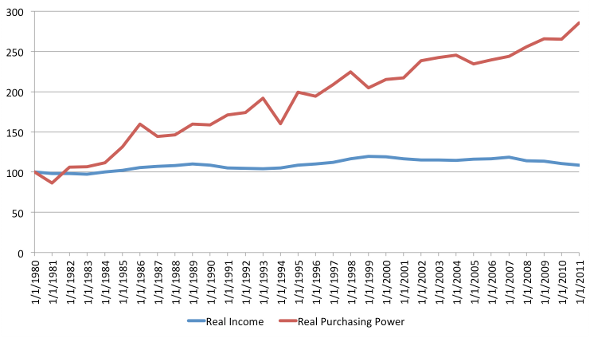Growth in Mortgage Purchasing Power
Posted Wednesday, April 03 2013

Above is a chart of real median household income and the real purchasing power of the same median household income when utilizing a 30-year mortgage. Said another way, if you kept the fraction of real median household income going towards a mortgage payment the same (say 30%), the red line shows the growth in what you could buy with your payment.
The chart highlights the dramatic rise in purchasing power of the median income household despite the lack of growth of the median household's real income. Growth in the capacity to borrow has replaced income growth over the last 30 years. Of course this is possible because interest rates have been falling continuously since the early 1980s making it feasible to borrow more and more with less income.
If we wanted to increase purchasing power in an environment where interest rates were not in decline, we'd need to see a substantial increase in real median income. For instance, say 30-year mortgage rates were at 6.5% instead of their recent level of roughly 3.5%. All else being equal, to get the same purchasing power as a 3.5% mortgage rate with a mortgage rate of 6.5% would require a 41% increase in real income! 1 Clearly (and by design in recent years), record low mortgage rates are a huge stimulus for home prices.
What happens when the 30+ year secular decline in interest rates ends? Even if rates stay low, the stimulus of declining rates on asset prices (homes in particular) will disappear. While incomes will likely increase over the next few years, we've already seen how much they would need to increase to match the purchasing power effects of falling interest rates. And if interest rates rise even modestly, purchasing power will be significantly curtailed. How home prices, under the additional influences of inertia and psychology, actually respond is another matter.

